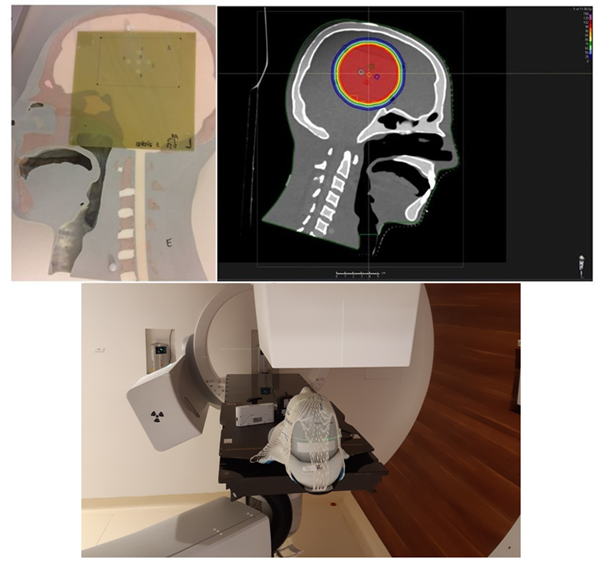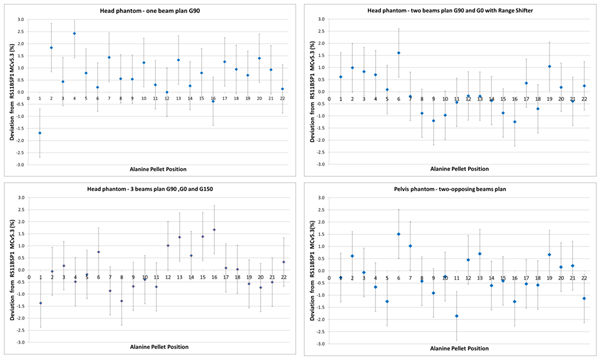E2E testing based on alanine and IC dosimetry for a new combination of TCS/OIS & PBS proton gantry
PO-1708
Abstract
E2E testing based on alanine and IC dosimetry for a new combination of TCS/OIS & PBS proton gantry
Authors: Patrick Roisl1, Hugo Palmans2,3, Mansure Schafasand4,5, Johannes Hopfgartner2, Markus Stock6,7, Antonio Carlino2
1EBG MedAustron GmbH, Medical Physics, Wiener Neustadt, Austria; 2EBG MedAustron, Medical Physics, Wiener Neustadt, Austria; 3National Physics Laboratory NPL, Institute of Physics, London, United Kingdom; 4EBG MedAustron Gmbh, PhD Student Medical Physics, Wiener Neustadt, Austria; 5Medical University of Vienna, PhD Student, Vienna, Austria; 6EBG MedAustron Gmbh, Medical Physics, Wiener Neustadt, Austria; 7Karl Landsteiner University of Health Sciences, Medical Physics, Wiener Neustadt, Austria
Show Affiliations
Hide Affiliations
Purpose or Objective
At MedAustron a new pencil beam scanning (PBS) proton gantry has been installed in combination with the newly developed Treatment Control System (TCS) RayCommand v2B SP2 and the Oncology Information System (OIS) RayCare v5A (RaySearch Laboratories, Sweden). The clinical implementation required comprehensive end-to-end (E2E) testing to ensure safe patient treatments. This work reports on functional and dosimetric E2E test procedures for protons based on customized phantoms and different dosimetric techniques.
Material and Methods
A homogeneous polystyrene phantom and two anthropomorphic phantoms (pelvis and head phantom) were adapted to hold different detectors.1 All treatment planning steps were performed with RayStation v11BSP1. The E2E tests were administered in RayCare and all treatment plans finally executed in RayCommand. First, image guided patient positioning was performed using the clinical RayCommand treatment workflow. Afterwards the plans were delivered to the phantoms which were loaded with alanine pellets (measurements of dose distribution) (figure 1) or a Farmer chamber (measurement of the dose at reference point) and additional gafchromic films. The alanine pellets and their read-out were provided by the National Physical Laboratory (NPL) in UK. Evaluation of the measurement results was performed according to Carlino et al, 2018 (1).

Figure 1: E2E test procedure with the head phantom. Top left: the loading of the phantom with alanine pellets and EBT3 films. Top right: the treatment plan preparation in RayStation v11B SPC1. Bottom: the positioning and irradiation with actively scanned proton beams.
Results
The clinical workflow of RayCare as OIS and RayCommand as TCS allowed a smooth and intuitive preparation and delivery of the E2E-test treatment plans. The measured absolute dose to water obtained with the Farmer chamber in four delivered plans, which included combinations of 0°, 90° and 150° gantry beams, was within 2% of the planned dose. Doses determined with the alanine pellets after correction for the quenching effect showed a mean deviation from the planned doses within 0.23% with a std. deviation of 0.8% and a maximum deviation below 2.5% for all the phantoms (figure 2).

Figure 2: Relative deviations of alanine measurements from TPS calculated dose in 4 irradiated plans
Conclusion
The end-to-end test procedures showed that the gantry in combination with the dedicated OIS RayCare and TCS RayCommand provides the possibility to prepare and deliver treatment plans in a well structured workflow and with accurate dosimetric precision.
(1) Carlino, Antonio & Gouldstone, Clare & Kragl, Gabriele & Traneus, E. & Marrale, Maurizio & Vatnitsky, Stanislav & Stock, Markus & Palmans, Hugo. (2018). End-to-end tests using alanine dosimetry in scanned proton beams. Physics in Medicine and Biology. 63. 10.1088/1361-6560/aaac23.